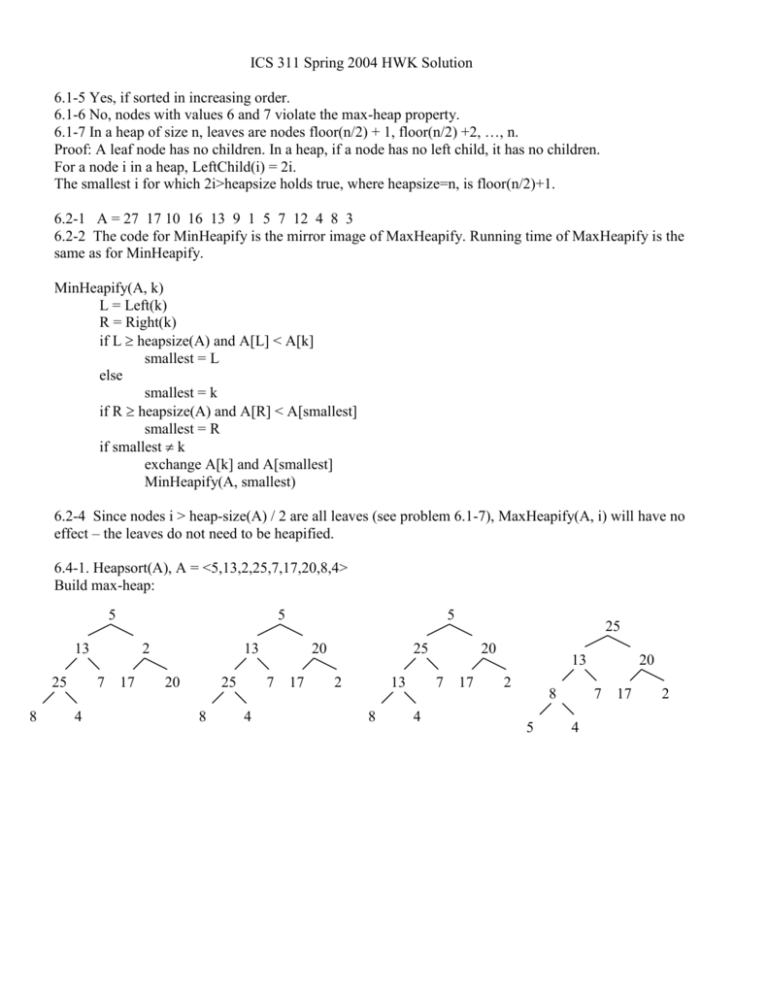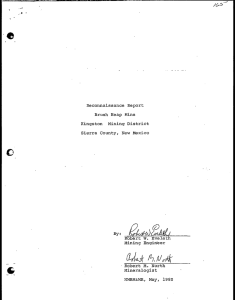smallest prove
advertisement

ICS 311 Spring 2004 HWK Solution
6.1-5 Yes, if sorted in increasing order.
6.1-6 No, nodes with values 6 and 7 violate the max-heap property.
6.1-7 In a heap of size n, leaves are nodes floor(n/2) + 1, floor(n/2) +2, …, n.
Proof: A leaf node has no children. In a heap, if a node has no left child, it has no children.
For a node i in a heap, LeftChild(i) = 2i.
The smallest i for which 2i>heapsize holds true, where heapsize=n, is floor(n/2)+1.
6.2-1 A = 27 17 10 16 13 9 1 5 7 12 4 8 3
6.2-2 The code for MinHeapify is the mirror image of MaxHeapify. Running time of MaxHeapify is the
same as for MinHeapify.
MinHeapify(A, k)
L = Left(k)
R = Right(k)
if L heapsize(A) and A[L] < A[k]
smallest = L
else
smallest = k
if R heapsize(A) and A[R] < A[smallest]
smallest = R
if smallest k
exchange A[k] and A[smallest]
MinHeapify(A, smallest)
6.2-4 Since nodes i > heap-size(A) / 2 are all leaves (see problem 6.1-7), MaxHeapify(A, i) will have no
effect – the leaves do not need to be heapified.
6.4-1. Heapsort(A), A = <5,13,2,25,7,17,20,8,4>
Build max-heap:
5
5
13
25
8
2
7
4
17
5
13
20
25
8
20
7
4
17
25
25
2
13
8
20
7
4
17
13
2
8
5
20
7
4
17
2
Start the for loop:
4
20
13
8
20
5
7
17
13
2
8
25
5
2
8
17
7
4
20
25
7
13
17
7
17
20
25
5
4
2
5
2
20
25
8
4
5
7
25
13
17
20
25
2
4
13
8
5
4
5
2
13
2
20
8
7 4
8
13
5
2
7
17
4
13
17
17
7 4
2
8
5
7
8
13
17
4
5
20
25
7
8
2
13
17
20
25
Final A = <2,4,5,7,8,13,17,20,25>
6.4-2 Heapsort for loop LI: subarray A[1, … i] is a max-heap containing the i smallest elements of A[1, ..n]
and the subarray A[i+1, … n] contains the n-i largest elements of A[1, …n].
Proof: Prove for initialization, maintenance, and termination.
Initialization (i=n): A[1,…n] is a max heap because we just called BuildMaxHeap. A[1, …n] contains the n
smallest elements of A[1, …n], and A[n+1, …n] is an undefined array, so by the trivial case it contains
n-n=0 largest elements of A[1, …n].
Maintenance (i = n-1, n-2, …. 2): array A[1, …i] is a max heap because we call MaxHeapify before entering
the loop. A[1, …i] is the max-heap of smallest elements. The largest elements have been extracted out of the
heap and are stored in increasing order in A[i+1, …n].
Termination (i = 1): A[1, …1] is one element heap, so it is a max-heap, and it contains the smallest element
of A[1, ….n]. The rest of the array contains the largest elements in increasing order.
6.5-1 A = 15 13 9 5 12 8 7 4 0 6 2 1 becomes 13 12 9 5 6 8 7 4 0 1 2 , and 15 is returned.
6.5-2 MaxHeapInsert(A,10), A=<15,13,9,5,12,8,7,4,0,6,2,1>
15
15
13
5
4
6-2
9
12
06
8
21
13
7
10
5
4
9
12
06
15
21
13
10
7
8
5
4
10
12
06
9
21
7
8
Complete d-ary heap is an almost complete d-ary tree: each internal node has d children. Node 1 is the
root.
Children of node 1 are at nodes 2,3, …, d+1.
Children of node 2 are at nodes (d+1) +1, …, (d+1) +d.
Children of node 3 are at nodes (2d+1)+1, …, (2d+1)+d.
Children of node i are at nodes (i-1)d+1+1, …, (i-1)d+1+d.
jth child of node i is at node (i-1)d+1+j, where 1≤ j ≤ d.
Therefore, d-ary child j of node i is found as d_aryChild(i,j) = (i-1)d+1+j.
So, nodes (k-1)d+1+1, …, (k-1)d+1+d have parent at node k.
Therefore, k = d-aryParent(z) = floor((z-2)/d + 1), where
z = (k-1)d+1+1, …, (k-1)d+1+d.
Check: d_aryParent(d_aryChild(i,j)) = i.
Check: do we get the binary heap formulas for d=2?
b) For a d-ary complete tree of total n nodes:
At level 0, we have 1 node (the root).
At level 2, we have d nodes.
At level 3, we have d2 nodes.
At level h, we have dh nodes, where h is the height of the tree.
So, n = ∑ di , where i = 0, ..,h. According to the Appendix, this sum evaluates to
n = (dh+1 -1) / (d –1).
h+1 = logd (n(d-1) +1)
h = logd (n(d-1) +1) -1
h = Θ (logd n)
c) d_aryHeapMaxExtract(A) {
//the code is the same as for HeapMaxExtract, except that
//we use d_aryMaxHeapify
}
d_aryMaxHeapify(A, i) {
//pseudocode is the same as MaxHeapify, except that in this function we
//must compare i to all d children of i, not only 2 children
child1=d_aryChild(i,1)
child2=d_aryChild(i,2)
…
childd=d_aryChild(i,d)
if A[child1] > A[i]
largest = child1
else
largest = i
if A[child2] > A[largest]
largest = child2
…
if A[childd] > A[largest]
Largest = childd
if largest ≠ i,
exchange A[i] and A[largest]
d_aryMaxHeapify(A, largest)
Running time of Maxheapify is O(lgn).
Running time for d_aryMaxHeapify is O(d logd n), i.e. the height of the tree multiplied with the
number of children examined at each node (which is at most d).
Running time for d_aryHeapMaxExtract is O(d logd n).
d) d_aryHeapInsert is the same code as for MaxHeapInsert, except that Parent(i) will be replaced by
d_aryParent(i). Therefore, the running time is Θ(height). For the d-ary heap, it is then Θ(logd n).
e) d_aryHeapIncreaseKey(A,i,k) { // a slight modification of MaxHeapInsert
A[i] = max(A[i], k)
while (i>1 and A[d_aryParent(i)] < A[i])
exchange A[i] and A[d_aryParent(i)]
i = d_aryParent(i)
The worst case: traveling up the entire tree, Therefore, the running time is Θ(height). For the d-ary
heap, it is then Θ(logd n).
6-1 BuildMaxHeap’(A) and BuildMaxHeap don’t produce the same heap out of the same array! Try it
on the array from the book, or just simply array A=<1,2,3>.
BuildMaxHeap’ works by building a heap starting from one element and inserting new elements. The
heap sequence is:
1 -∞
1 2
2 1
2 1 -∞
213
312
BuildMaxHeap works by max heapifying from the bottom up, produces:
123
321







